Analyzing Healthcare Spending Trends: A US vs Netherlands Comparison
VerifiedAdded on 2022/11/29
|8
|1964
|159
Report
AI Summary
This report provides a comparative analysis of healthcare spending trends in the United States and the Netherlands. It highlights the significantly higher healthcare expenditure in the US compared to the Netherlands, despite the latter's superior health outcomes and broader coverage. The report delves into the factors contributing to these disparities, including differences in healthcare systems, insurance models, and the impact of the Affordable Care Act in the US. It also explores the economics of healthcare reform, discussing potential strategies to improve efficiency, expand access to care, and address health inequalities in the US. The report references various studies and reports to support its findings, offering insights into the complexities of healthcare spending and the challenges of achieving optimal healthcare outcomes.
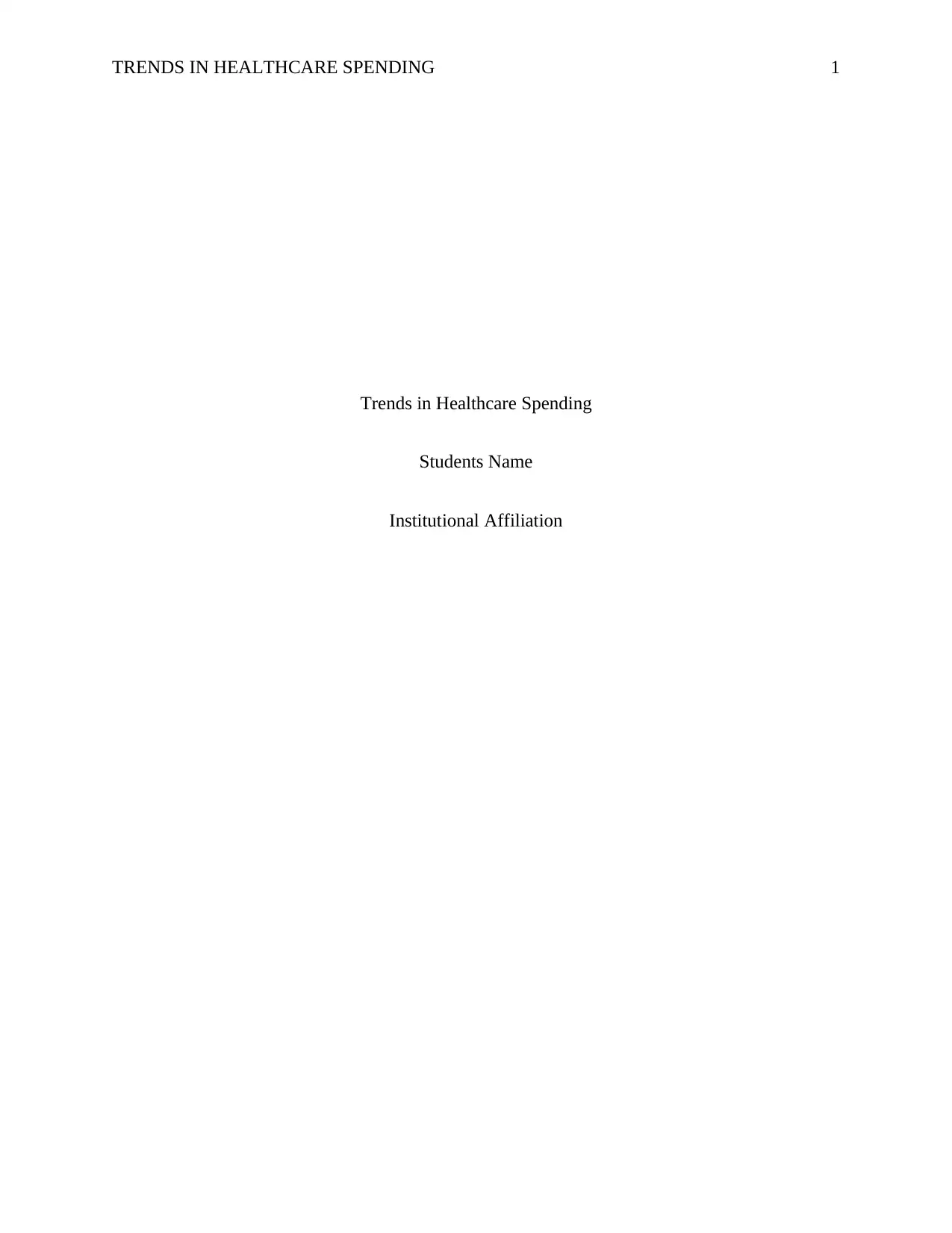
TRENDS IN HEALTHCARE SPENDING 1
Trends in Healthcare Spending
Students Name
Institutional Affiliation
Trends in Healthcare Spending
Students Name
Institutional Affiliation
Paraphrase This Document
Need a fresh take? Get an instant paraphrase of this document with our AI Paraphraser
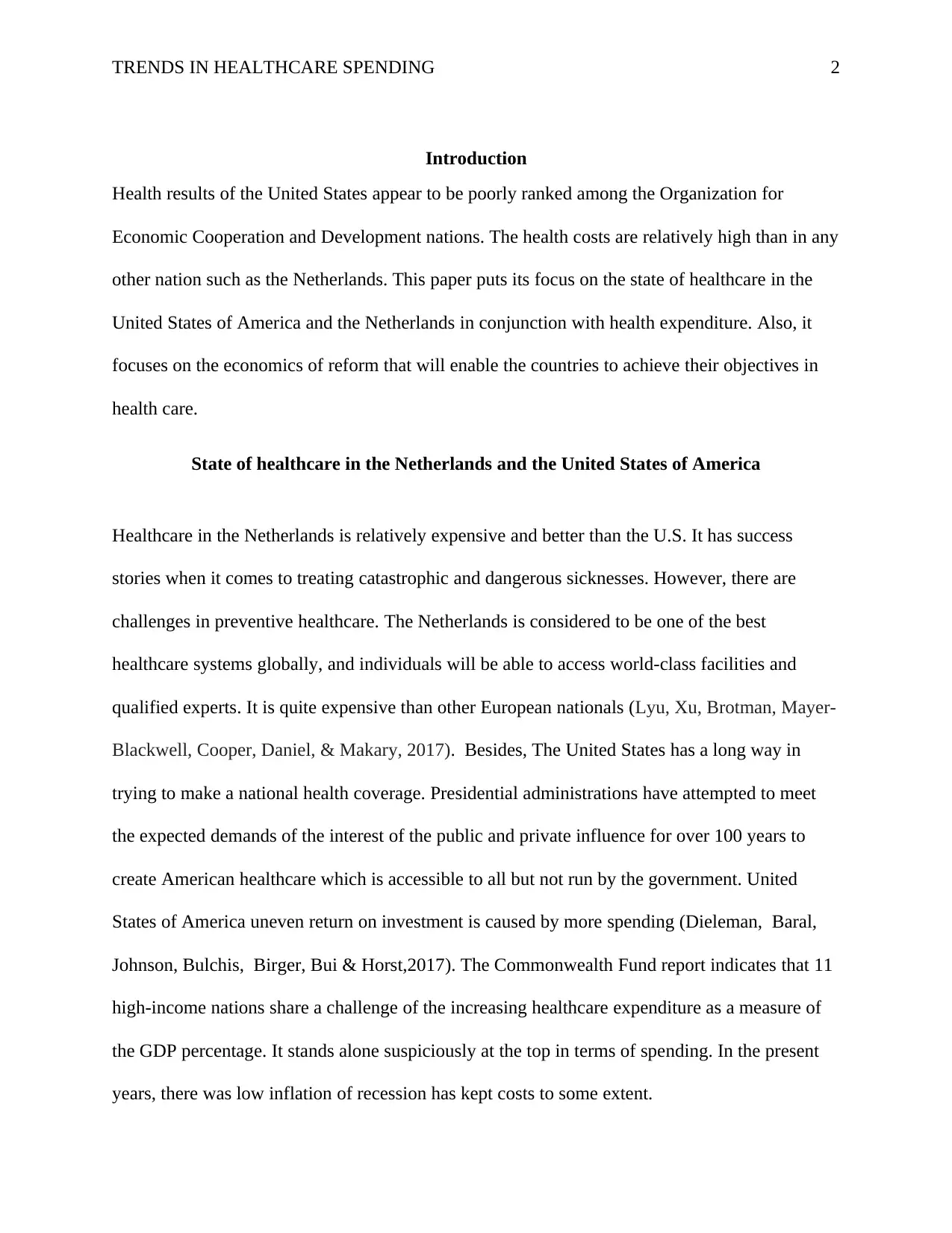
TRENDS IN HEALTHCARE SPENDING 2
Introduction
Health results of the United States appear to be poorly ranked among the Organization for
Economic Cooperation and Development nations. The health costs are relatively high than in any
other nation such as the Netherlands. This paper puts its focus on the state of healthcare in the
United States of America and the Netherlands in conjunction with health expenditure. Also, it
focuses on the economics of reform that will enable the countries to achieve their objectives in
health care.
State of healthcare in the Netherlands and the United States of America
Healthcare in the Netherlands is relatively expensive and better than the U.S. It has success
stories when it comes to treating catastrophic and dangerous sicknesses. However, there are
challenges in preventive healthcare. The Netherlands is considered to be one of the best
healthcare systems globally, and individuals will be able to access world-class facilities and
qualified experts. It is quite expensive than other European nationals (Lyu, Xu, Brotman, Mayer-
Blackwell, Cooper, Daniel, & Makary, 2017). Besides, The United States has a long way in
trying to make a national health coverage. Presidential administrations have attempted to meet
the expected demands of the interest of the public and private influence for over 100 years to
create American healthcare which is accessible to all but not run by the government. United
States of America uneven return on investment is caused by more spending (Dieleman, Baral,
Johnson, Bulchis, Birger, Bui & Horst,2017). The Commonwealth Fund report indicates that 11
high-income nations share a challenge of the increasing healthcare expenditure as a measure of
the GDP percentage. It stands alone suspiciously at the top in terms of spending. In the present
years, there was low inflation of recession has kept costs to some extent.
Introduction
Health results of the United States appear to be poorly ranked among the Organization for
Economic Cooperation and Development nations. The health costs are relatively high than in any
other nation such as the Netherlands. This paper puts its focus on the state of healthcare in the
United States of America and the Netherlands in conjunction with health expenditure. Also, it
focuses on the economics of reform that will enable the countries to achieve their objectives in
health care.
State of healthcare in the Netherlands and the United States of America
Healthcare in the Netherlands is relatively expensive and better than the U.S. It has success
stories when it comes to treating catastrophic and dangerous sicknesses. However, there are
challenges in preventive healthcare. The Netherlands is considered to be one of the best
healthcare systems globally, and individuals will be able to access world-class facilities and
qualified experts. It is quite expensive than other European nationals (Lyu, Xu, Brotman, Mayer-
Blackwell, Cooper, Daniel, & Makary, 2017). Besides, The United States has a long way in
trying to make a national health coverage. Presidential administrations have attempted to meet
the expected demands of the interest of the public and private influence for over 100 years to
create American healthcare which is accessible to all but not run by the government. United
States of America uneven return on investment is caused by more spending (Dieleman, Baral,
Johnson, Bulchis, Birger, Bui & Horst,2017). The Commonwealth Fund report indicates that 11
high-income nations share a challenge of the increasing healthcare expenditure as a measure of
the GDP percentage. It stands alone suspiciously at the top in terms of spending. In the present
years, there was low inflation of recession has kept costs to some extent.
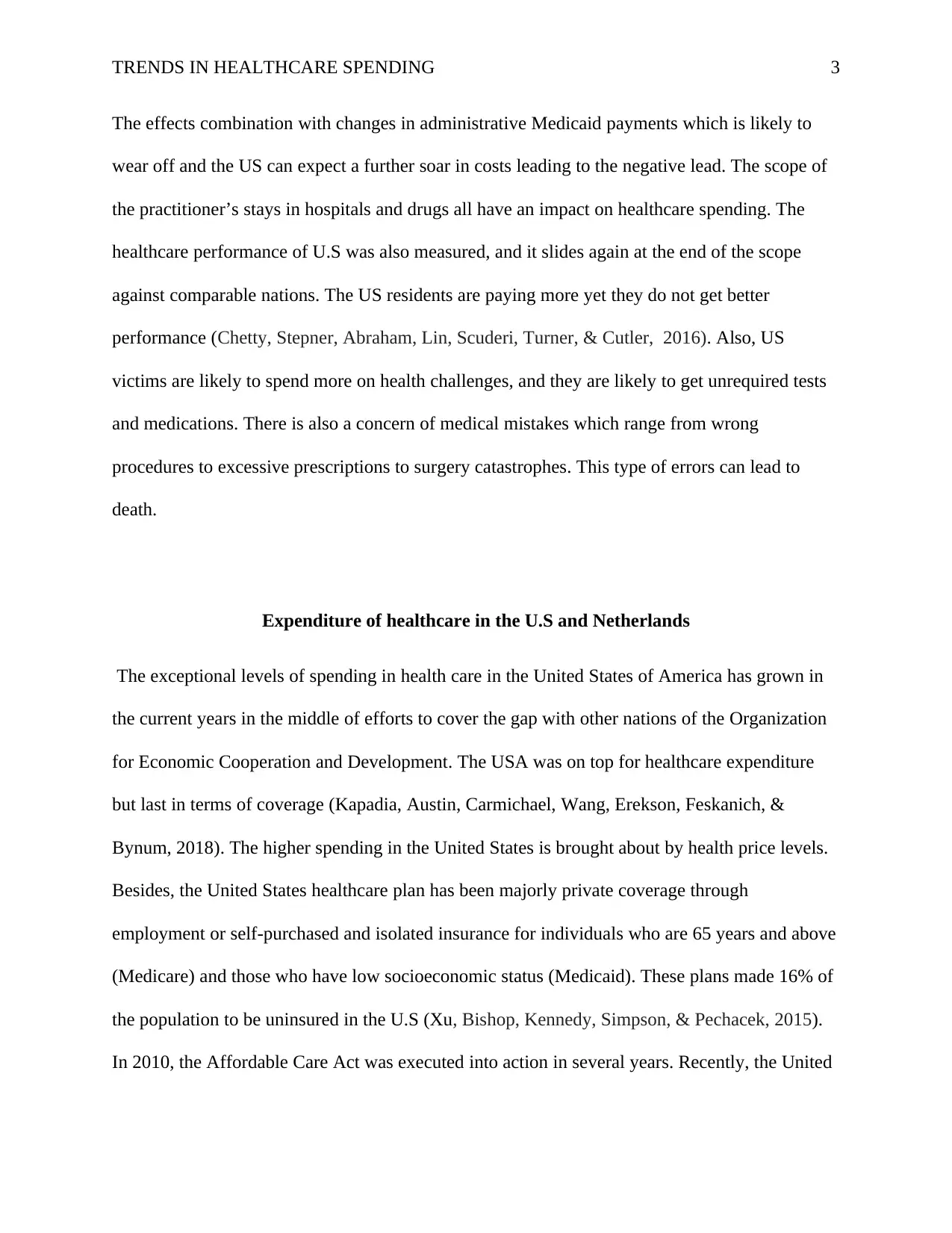
TRENDS IN HEALTHCARE SPENDING 3
The effects combination with changes in administrative Medicaid payments which is likely to
wear off and the US can expect a further soar in costs leading to the negative lead. The scope of
the practitioner’s stays in hospitals and drugs all have an impact on healthcare spending. The
healthcare performance of U.S was also measured, and it slides again at the end of the scope
against comparable nations. The US residents are paying more yet they do not get better
performance (Chetty, Stepner, Abraham, Lin, Scuderi, Turner, & Cutler, 2016). Also, US
victims are likely to spend more on health challenges, and they are likely to get unrequired tests
and medications. There is also a concern of medical mistakes which range from wrong
procedures to excessive prescriptions to surgery catastrophes. This type of errors can lead to
death.
Expenditure of healthcare in the U.S and Netherlands
The exceptional levels of spending in health care in the United States of America has grown in
the current years in the middle of efforts to cover the gap with other nations of the Organization
for Economic Cooperation and Development. The USA was on top for healthcare expenditure
but last in terms of coverage (Kapadia, Austin, Carmichael, Wang, Erekson, Feskanich, &
Bynum, 2018). The higher spending in the United States is brought about by health price levels.
Besides, the United States healthcare plan has been majorly private coverage through
employment or self-purchased and isolated insurance for individuals who are 65 years and above
(Medicare) and those who have low socioeconomic status (Medicaid). These plans made 16% of
the population to be uninsured in the U.S (Xu, Bishop, Kennedy, Simpson, & Pechacek, 2015).
In 2010, the Affordable Care Act was executed into action in several years. Recently, the United
The effects combination with changes in administrative Medicaid payments which is likely to
wear off and the US can expect a further soar in costs leading to the negative lead. The scope of
the practitioner’s stays in hospitals and drugs all have an impact on healthcare spending. The
healthcare performance of U.S was also measured, and it slides again at the end of the scope
against comparable nations. The US residents are paying more yet they do not get better
performance (Chetty, Stepner, Abraham, Lin, Scuderi, Turner, & Cutler, 2016). Also, US
victims are likely to spend more on health challenges, and they are likely to get unrequired tests
and medications. There is also a concern of medical mistakes which range from wrong
procedures to excessive prescriptions to surgery catastrophes. This type of errors can lead to
death.
Expenditure of healthcare in the U.S and Netherlands
The exceptional levels of spending in health care in the United States of America has grown in
the current years in the middle of efforts to cover the gap with other nations of the Organization
for Economic Cooperation and Development. The USA was on top for healthcare expenditure
but last in terms of coverage (Kapadia, Austin, Carmichael, Wang, Erekson, Feskanich, &
Bynum, 2018). The higher spending in the United States is brought about by health price levels.
Besides, the United States healthcare plan has been majorly private coverage through
employment or self-purchased and isolated insurance for individuals who are 65 years and above
(Medicare) and those who have low socioeconomic status (Medicaid). These plans made 16% of
the population to be uninsured in the U.S (Xu, Bishop, Kennedy, Simpson, & Pechacek, 2015).
In 2010, the Affordable Care Act was executed into action in several years. Recently, the United
⊘ This is a preview!⊘
Do you want full access?
Subscribe today to unlock all pages.

Trusted by 1+ million students worldwide
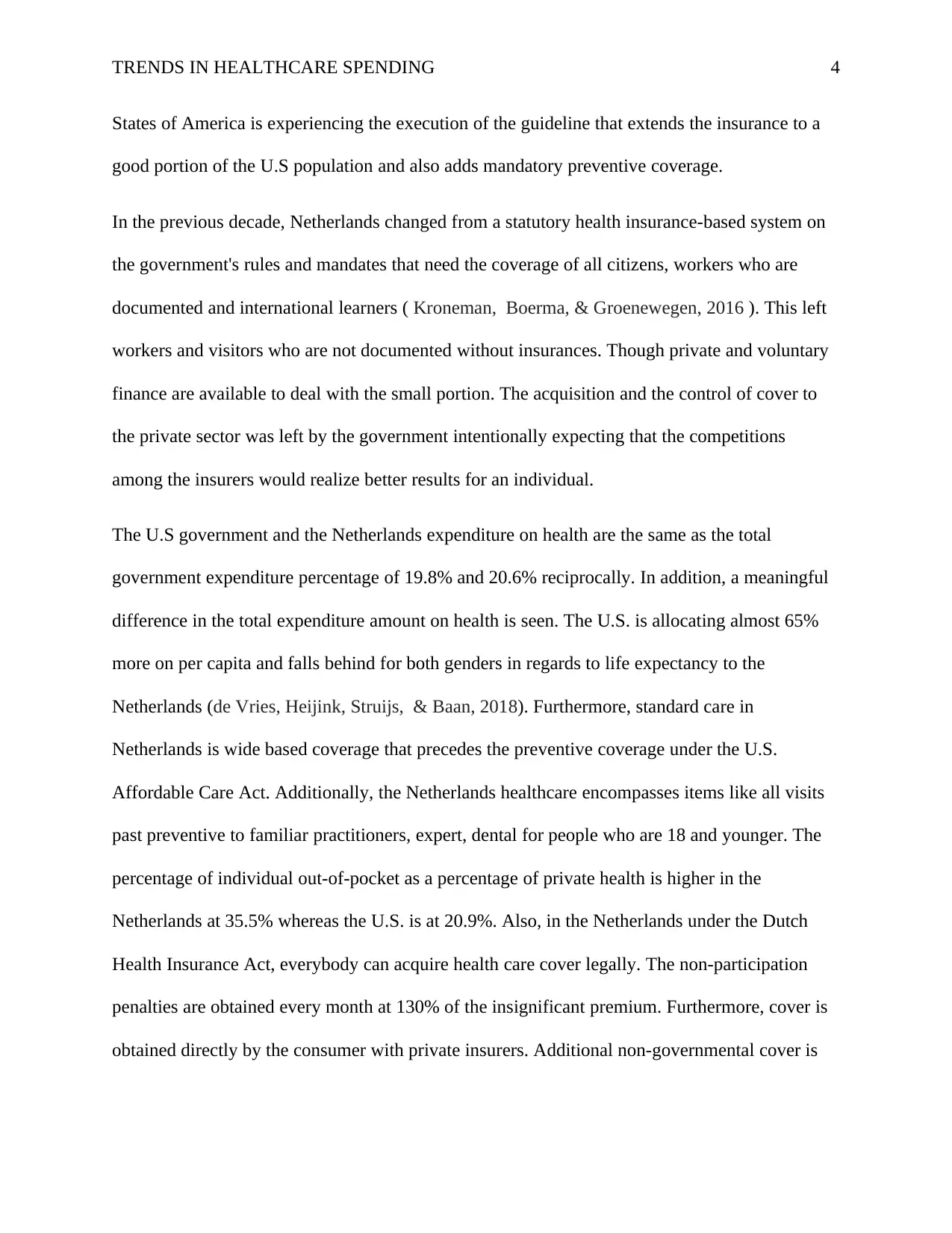
TRENDS IN HEALTHCARE SPENDING 4
States of America is experiencing the execution of the guideline that extends the insurance to a
good portion of the U.S population and also adds mandatory preventive coverage.
In the previous decade, Netherlands changed from a statutory health insurance-based system on
the government's rules and mandates that need the coverage of all citizens, workers who are
documented and international learners ( Kroneman, Boerma, & Groenewegen, 2016 ). This left
workers and visitors who are not documented without insurances. Though private and voluntary
finance are available to deal with the small portion. The acquisition and the control of cover to
the private sector was left by the government intentionally expecting that the competitions
among the insurers would realize better results for an individual.
The U.S government and the Netherlands expenditure on health are the same as the total
government expenditure percentage of 19.8% and 20.6% reciprocally. In addition, a meaningful
difference in the total expenditure amount on health is seen. The U.S. is allocating almost 65%
more on per capita and falls behind for both genders in regards to life expectancy to the
Netherlands (de Vries, Heijink, Struijs, & Baan, 2018). Furthermore, standard care in
Netherlands is wide based coverage that precedes the preventive coverage under the U.S.
Affordable Care Act. Additionally, the Netherlands healthcare encompasses items like all visits
past preventive to familiar practitioners, expert, dental for people who are 18 and younger. The
percentage of individual out-of-pocket as a percentage of private health is higher in the
Netherlands at 35.5% whereas the U.S. is at 20.9%. Also, in the Netherlands under the Dutch
Health Insurance Act, everybody can acquire health care cover legally. The non-participation
penalties are obtained every month at 130% of the insignificant premium. Furthermore, cover is
obtained directly by the consumer with private insurers. Additional non-governmental cover is
States of America is experiencing the execution of the guideline that extends the insurance to a
good portion of the U.S population and also adds mandatory preventive coverage.
In the previous decade, Netherlands changed from a statutory health insurance-based system on
the government's rules and mandates that need the coverage of all citizens, workers who are
documented and international learners ( Kroneman, Boerma, & Groenewegen, 2016 ). This left
workers and visitors who are not documented without insurances. Though private and voluntary
finance are available to deal with the small portion. The acquisition and the control of cover to
the private sector was left by the government intentionally expecting that the competitions
among the insurers would realize better results for an individual.
The U.S government and the Netherlands expenditure on health are the same as the total
government expenditure percentage of 19.8% and 20.6% reciprocally. In addition, a meaningful
difference in the total expenditure amount on health is seen. The U.S. is allocating almost 65%
more on per capita and falls behind for both genders in regards to life expectancy to the
Netherlands (de Vries, Heijink, Struijs, & Baan, 2018). Furthermore, standard care in
Netherlands is wide based coverage that precedes the preventive coverage under the U.S.
Affordable Care Act. Additionally, the Netherlands healthcare encompasses items like all visits
past preventive to familiar practitioners, expert, dental for people who are 18 and younger. The
percentage of individual out-of-pocket as a percentage of private health is higher in the
Netherlands at 35.5% whereas the U.S. is at 20.9%. Also, in the Netherlands under the Dutch
Health Insurance Act, everybody can acquire health care cover legally. The non-participation
penalties are obtained every month at 130% of the insignificant premium. Furthermore, cover is
obtained directly by the consumer with private insurers. Additional non-governmental cover is
Paraphrase This Document
Need a fresh take? Get an instant paraphrase of this document with our AI Paraphraser
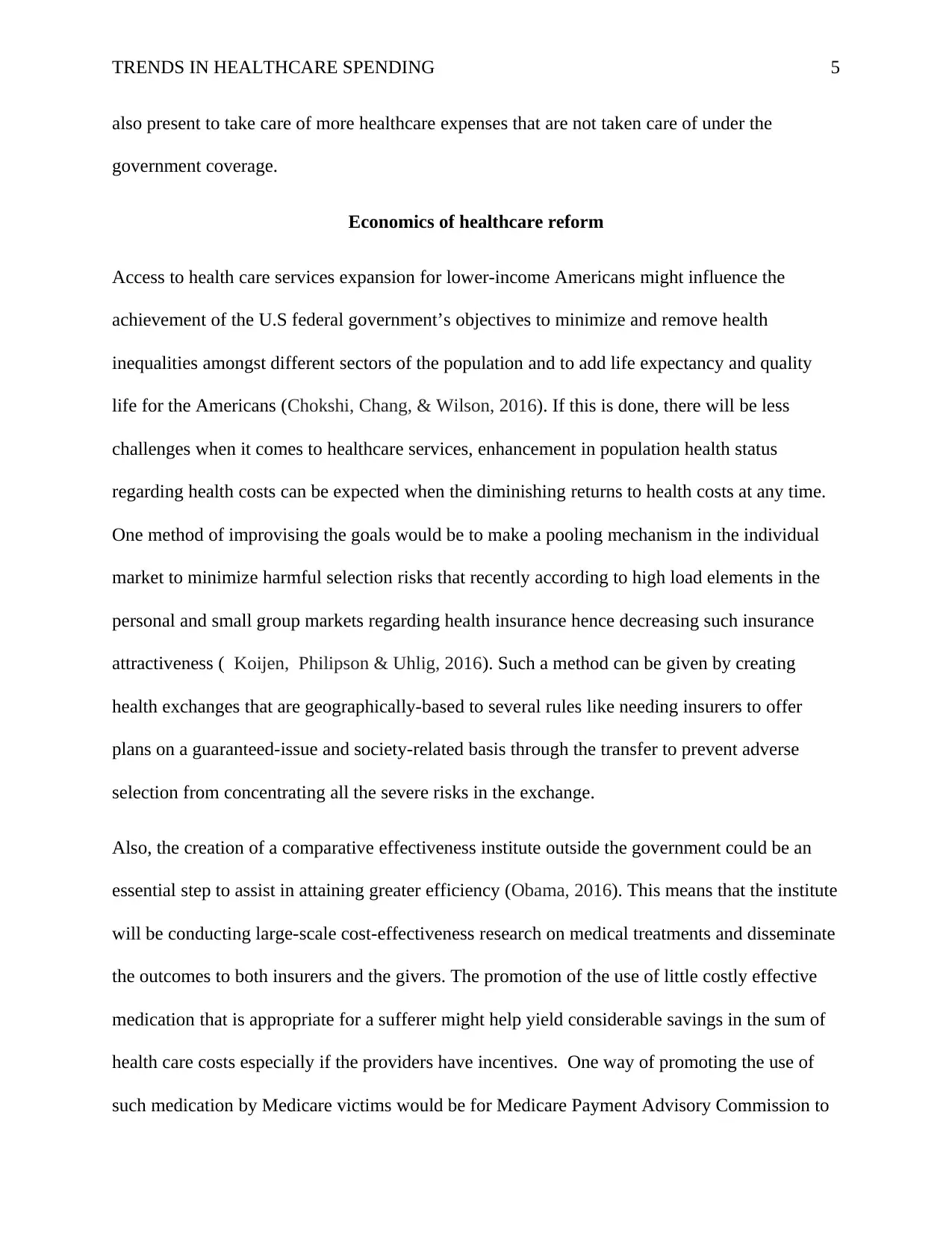
TRENDS IN HEALTHCARE SPENDING 5
also present to take care of more healthcare expenses that are not taken care of under the
government coverage.
Economics of healthcare reform
Access to health care services expansion for lower-income Americans might influence the
achievement of the U.S federal government’s objectives to minimize and remove health
inequalities amongst different sectors of the population and to add life expectancy and quality
life for the Americans (Chokshi, Chang, & Wilson, 2016). If this is done, there will be less
challenges when it comes to healthcare services, enhancement in population health status
regarding health costs can be expected when the diminishing returns to health costs at any time.
One method of improvising the goals would be to make a pooling mechanism in the individual
market to minimize harmful selection risks that recently according to high load elements in the
personal and small group markets regarding health insurance hence decreasing such insurance
attractiveness ( Koijen, Philipson & Uhlig, 2016). Such a method can be given by creating
health exchanges that are geographically-based to several rules like needing insurers to offer
plans on a guaranteed-issue and society-related basis through the transfer to prevent adverse
selection from concentrating all the severe risks in the exchange.
Also, the creation of a comparative effectiveness institute outside the government could be an
essential step to assist in attaining greater efficiency (Obama, 2016). This means that the institute
will be conducting large-scale cost-effectiveness research on medical treatments and disseminate
the outcomes to both insurers and the givers. The promotion of the use of little costly effective
medication that is appropriate for a sufferer might help yield considerable savings in the sum of
health care costs especially if the providers have incentives. One way of promoting the use of
such medication by Medicare victims would be for Medicare Payment Advisory Commission to
also present to take care of more healthcare expenses that are not taken care of under the
government coverage.
Economics of healthcare reform
Access to health care services expansion for lower-income Americans might influence the
achievement of the U.S federal government’s objectives to minimize and remove health
inequalities amongst different sectors of the population and to add life expectancy and quality
life for the Americans (Chokshi, Chang, & Wilson, 2016). If this is done, there will be less
challenges when it comes to healthcare services, enhancement in population health status
regarding health costs can be expected when the diminishing returns to health costs at any time.
One method of improvising the goals would be to make a pooling mechanism in the individual
market to minimize harmful selection risks that recently according to high load elements in the
personal and small group markets regarding health insurance hence decreasing such insurance
attractiveness ( Koijen, Philipson & Uhlig, 2016). Such a method can be given by creating
health exchanges that are geographically-based to several rules like needing insurers to offer
plans on a guaranteed-issue and society-related basis through the transfer to prevent adverse
selection from concentrating all the severe risks in the exchange.
Also, the creation of a comparative effectiveness institute outside the government could be an
essential step to assist in attaining greater efficiency (Obama, 2016). This means that the institute
will be conducting large-scale cost-effectiveness research on medical treatments and disseminate
the outcomes to both insurers and the givers. The promotion of the use of little costly effective
medication that is appropriate for a sufferer might help yield considerable savings in the sum of
health care costs especially if the providers have incentives. One way of promoting the use of
such medication by Medicare victims would be for Medicare Payment Advisory Commission to
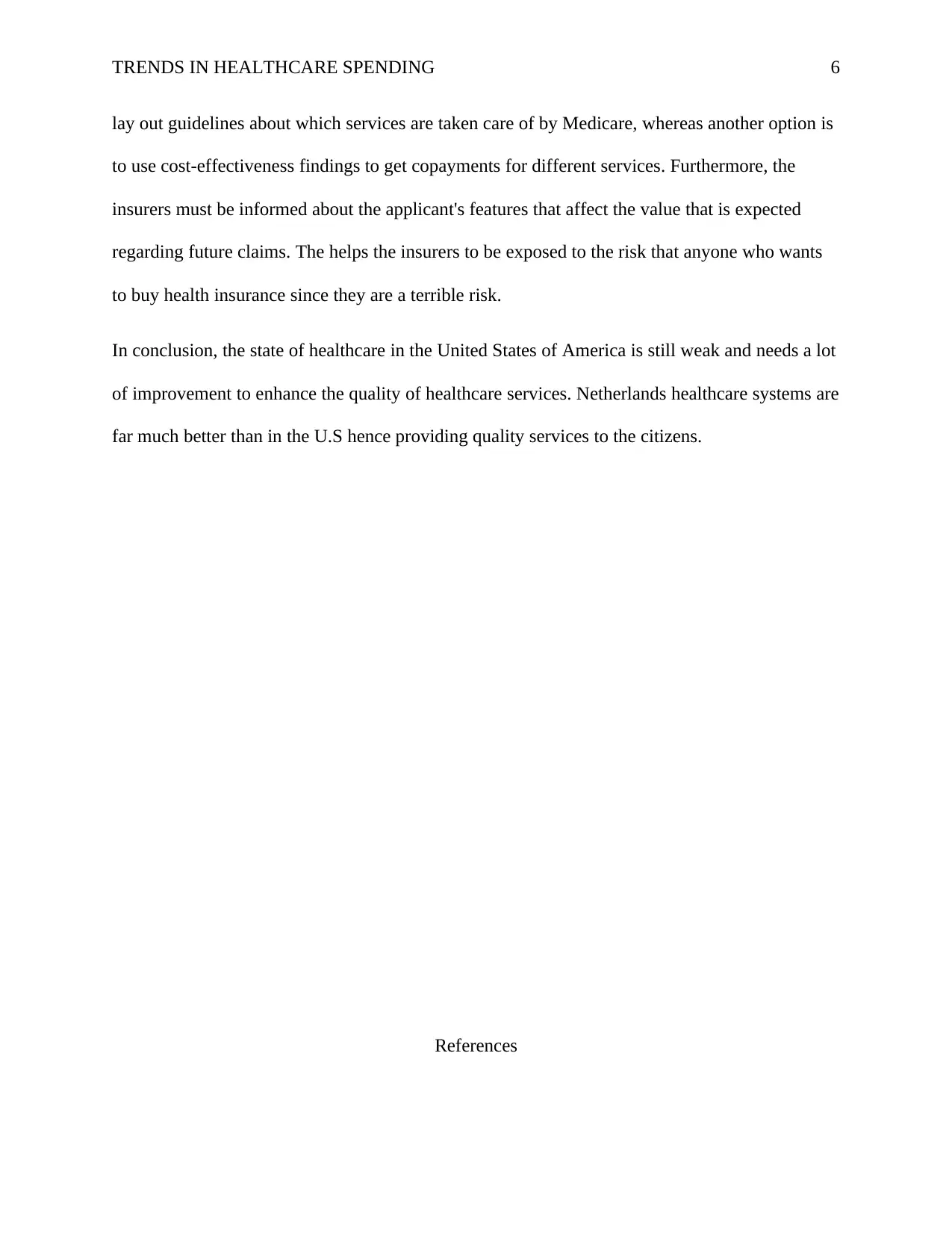
TRENDS IN HEALTHCARE SPENDING 6
lay out guidelines about which services are taken care of by Medicare, whereas another option is
to use cost-effectiveness findings to get copayments for different services. Furthermore, the
insurers must be informed about the applicant's features that affect the value that is expected
regarding future claims. The helps the insurers to be exposed to the risk that anyone who wants
to buy health insurance since they are a terrible risk.
In conclusion, the state of healthcare in the United States of America is still weak and needs a lot
of improvement to enhance the quality of healthcare services. Netherlands healthcare systems are
far much better than in the U.S hence providing quality services to the citizens.
References
lay out guidelines about which services are taken care of by Medicare, whereas another option is
to use cost-effectiveness findings to get copayments for different services. Furthermore, the
insurers must be informed about the applicant's features that affect the value that is expected
regarding future claims. The helps the insurers to be exposed to the risk that anyone who wants
to buy health insurance since they are a terrible risk.
In conclusion, the state of healthcare in the United States of America is still weak and needs a lot
of improvement to enhance the quality of healthcare services. Netherlands healthcare systems are
far much better than in the U.S hence providing quality services to the citizens.
References
⊘ This is a preview!⊘
Do you want full access?
Subscribe today to unlock all pages.

Trusted by 1+ million students worldwide
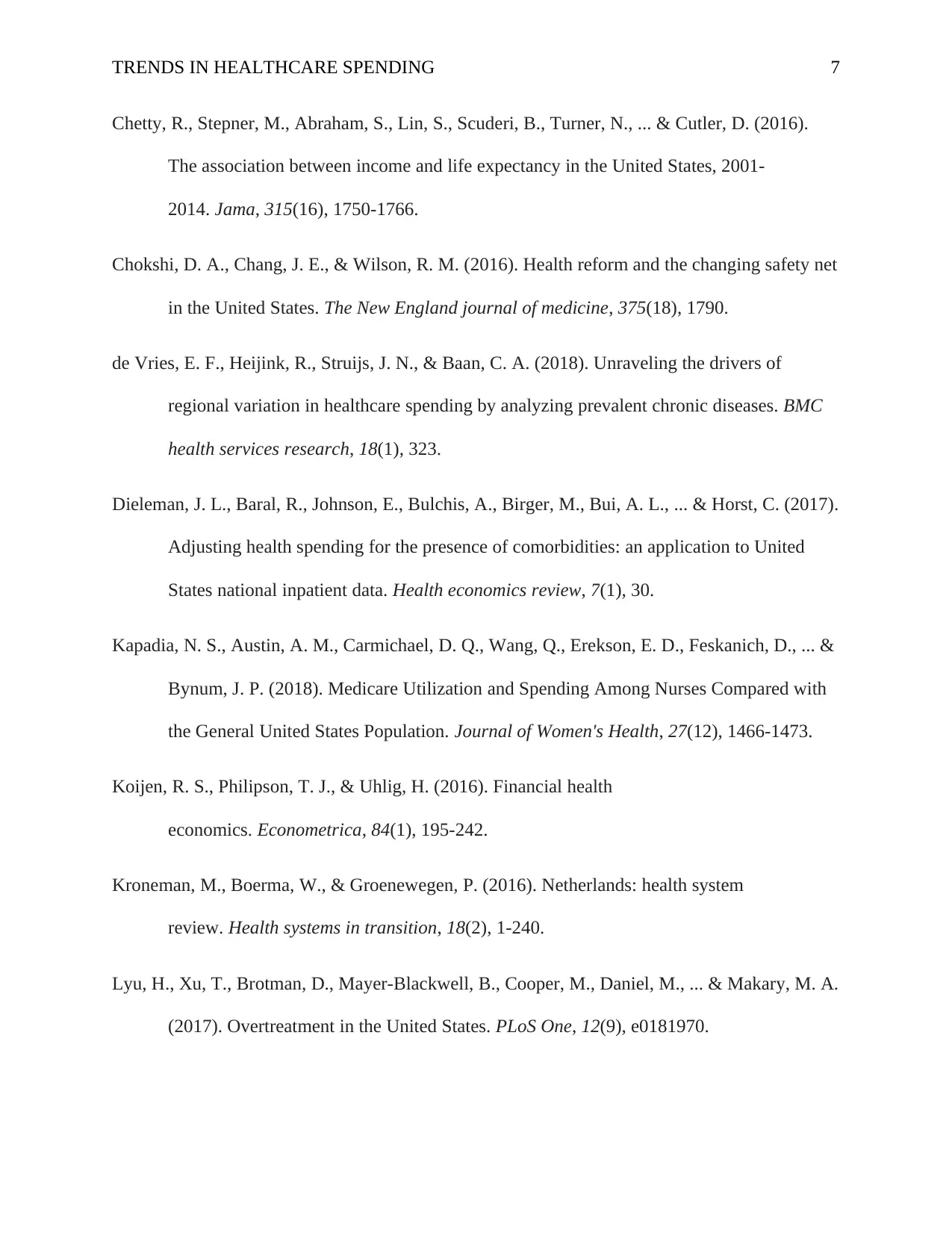
TRENDS IN HEALTHCARE SPENDING 7
Chetty, R., Stepner, M., Abraham, S., Lin, S., Scuderi, B., Turner, N., ... & Cutler, D. (2016).
The association between income and life expectancy in the United States, 2001-
2014. Jama, 315(16), 1750-1766.
Chokshi, D. A., Chang, J. E., & Wilson, R. M. (2016). Health reform and the changing safety net
in the United States. The New England journal of medicine, 375(18), 1790.
de Vries, E. F., Heijink, R., Struijs, J. N., & Baan, C. A. (2018). Unraveling the drivers of
regional variation in healthcare spending by analyzing prevalent chronic diseases. BMC
health services research, 18(1), 323.
Dieleman, J. L., Baral, R., Johnson, E., Bulchis, A., Birger, M., Bui, A. L., ... & Horst, C. (2017).
Adjusting health spending for the presence of comorbidities: an application to United
States national inpatient data. Health economics review, 7(1), 30.
Kapadia, N. S., Austin, A. M., Carmichael, D. Q., Wang, Q., Erekson, E. D., Feskanich, D., ... &
Bynum, J. P. (2018). Medicare Utilization and Spending Among Nurses Compared with
the General United States Population. Journal of Women's Health, 27(12), 1466-1473.
Koijen, R. S., Philipson, T. J., & Uhlig, H. (2016). Financial health
economics. Econometrica, 84(1), 195-242.
Kroneman, M., Boerma, W., & Groenewegen, P. (2016). Netherlands: health system
review. Health systems in transition, 18(2), 1-240.
Lyu, H., Xu, T., Brotman, D., Mayer-Blackwell, B., Cooper, M., Daniel, M., ... & Makary, M. A.
(2017). Overtreatment in the United States. PLoS One, 12(9), e0181970.
Chetty, R., Stepner, M., Abraham, S., Lin, S., Scuderi, B., Turner, N., ... & Cutler, D. (2016).
The association between income and life expectancy in the United States, 2001-
2014. Jama, 315(16), 1750-1766.
Chokshi, D. A., Chang, J. E., & Wilson, R. M. (2016). Health reform and the changing safety net
in the United States. The New England journal of medicine, 375(18), 1790.
de Vries, E. F., Heijink, R., Struijs, J. N., & Baan, C. A. (2018). Unraveling the drivers of
regional variation in healthcare spending by analyzing prevalent chronic diseases. BMC
health services research, 18(1), 323.
Dieleman, J. L., Baral, R., Johnson, E., Bulchis, A., Birger, M., Bui, A. L., ... & Horst, C. (2017).
Adjusting health spending for the presence of comorbidities: an application to United
States national inpatient data. Health economics review, 7(1), 30.
Kapadia, N. S., Austin, A. M., Carmichael, D. Q., Wang, Q., Erekson, E. D., Feskanich, D., ... &
Bynum, J. P. (2018). Medicare Utilization and Spending Among Nurses Compared with
the General United States Population. Journal of Women's Health, 27(12), 1466-1473.
Koijen, R. S., Philipson, T. J., & Uhlig, H. (2016). Financial health
economics. Econometrica, 84(1), 195-242.
Kroneman, M., Boerma, W., & Groenewegen, P. (2016). Netherlands: health system
review. Health systems in transition, 18(2), 1-240.
Lyu, H., Xu, T., Brotman, D., Mayer-Blackwell, B., Cooper, M., Daniel, M., ... & Makary, M. A.
(2017). Overtreatment in the United States. PLoS One, 12(9), e0181970.
Paraphrase This Document
Need a fresh take? Get an instant paraphrase of this document with our AI Paraphraser
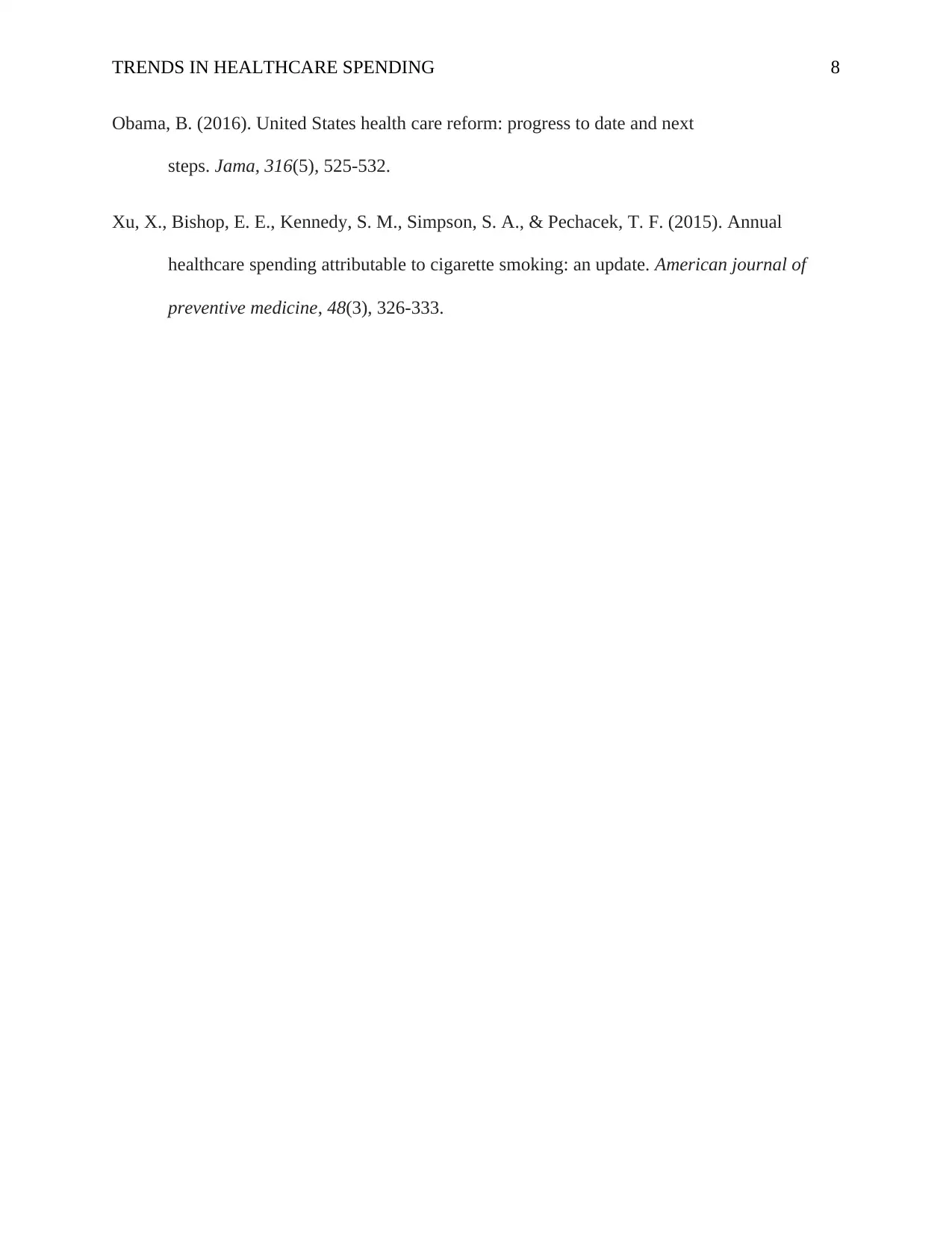
TRENDS IN HEALTHCARE SPENDING 8
Obama, B. (2016). United States health care reform: progress to date and next
steps. Jama, 316(5), 525-532.
Xu, X., Bishop, E. E., Kennedy, S. M., Simpson, S. A., & Pechacek, T. F. (2015). Annual
healthcare spending attributable to cigarette smoking: an update. American journal of
preventive medicine, 48(3), 326-333.
Obama, B. (2016). United States health care reform: progress to date and next
steps. Jama, 316(5), 525-532.
Xu, X., Bishop, E. E., Kennedy, S. M., Simpson, S. A., & Pechacek, T. F. (2015). Annual
healthcare spending attributable to cigarette smoking: an update. American journal of
preventive medicine, 48(3), 326-333.
1 out of 8
Related Documents
Your All-in-One AI-Powered Toolkit for Academic Success.
+13062052269
info@desklib.com
Available 24*7 on WhatsApp / Email
![[object Object]](/_next/static/media/star-bottom.7253800d.svg)
Unlock your academic potential
Copyright © 2020–2025 A2Z Services. All Rights Reserved. Developed and managed by ZUCOL.





